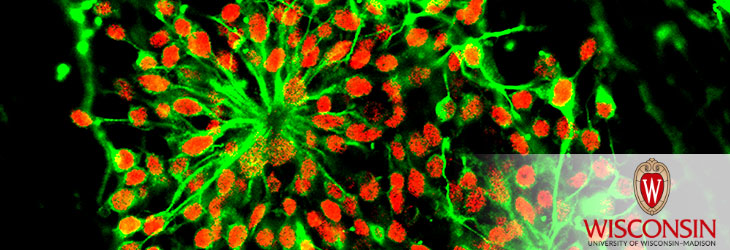Pluripotent Stem Cells

Methods for Generating Cardiac Fibroblasts
WARF: P210258US02
Inventors: Sean Palecek, Martha Floy
The Invention
UW-Madison researchers have developed a defined and efficient method to direct the differentiation of epicardial cells to produce cardiac fibroblast cells. This builds on Dr. Palacek’s prior innovation for differentiating hPSCs to epicardial cells (EpiCs). The inventors have compared their method and the resulting fibroblast population with two other published protocols, and identified distinctions in both the methods and the properties of the fibroblast cells. The diversity and complexity of cardiac cell subtypes, coupled with well characterized protocols for differentiating hPSCs to subtype-specific cardiac fibroblasts, enables researchers to choose the best cell type for their potential applications ranging from disease modelling, studying cardiac development, and tissue engineering for cardiac regeneration.
In the new protocol, hPSC-EpiCs at 100% confluence are treated with LaSR basal medium supplemented with 5 ng/mL bFGF and passaged at 7000 cells/cm2 in FibroGRO medium. Upon reaching 70-90% confluency, over 80% of cells stain positive for TE-7 and vimentin fibroblast markers as well as the pan-cardiac transcription factors ISL1 and GATA4. The hPSC-cardiac fibroblasts can be expanded for over 60 days, maintaining expression of both fibroblast markers and cardiac transcription factors. The hPSC-cardiac fibroblasts expressed transcriptomic similarity to primary adult and fetal cardiac fibroblasts. Proteomic analysis of deposited ECM proteins demonstrated that the secretome bears a greater similarity to fetal cardiac fibroblasts than adult. Functionally, hPSC-derived cardiac fibroblasts can be activated to a myofibroblast state by treatment with TGFbeta and angiotensin. They exhibited very little mineralization potential. When integrated into cardiac organoids, hPSC-cardiac fibroblasts accelerated calcium handling kinetics of hPSC-cardiomyocytes, suggesting a role in functional maturation of hPSC-derived cardiac tissues.
In the new protocol, hPSC-EpiCs at 100% confluence are treated with LaSR basal medium supplemented with 5 ng/mL bFGF and passaged at 7000 cells/cm2 in FibroGRO medium. Upon reaching 70-90% confluency, over 80% of cells stain positive for TE-7 and vimentin fibroblast markers as well as the pan-cardiac transcription factors ISL1 and GATA4. The hPSC-cardiac fibroblasts can be expanded for over 60 days, maintaining expression of both fibroblast markers and cardiac transcription factors. The hPSC-cardiac fibroblasts expressed transcriptomic similarity to primary adult and fetal cardiac fibroblasts. Proteomic analysis of deposited ECM proteins demonstrated that the secretome bears a greater similarity to fetal cardiac fibroblasts than adult. Functionally, hPSC-derived cardiac fibroblasts can be activated to a myofibroblast state by treatment with TGFbeta and angiotensin. They exhibited very little mineralization potential. When integrated into cardiac organoids, hPSC-cardiac fibroblasts accelerated calcium handling kinetics of hPSC-cardiomyocytes, suggesting a role in functional maturation of hPSC-derived cardiac tissues.
Additional Information
For More Information About the Inventors
Tech Fields
For current licensing status, please contact Andy DeTienne at [javascript protected email address] or 608-960-9857